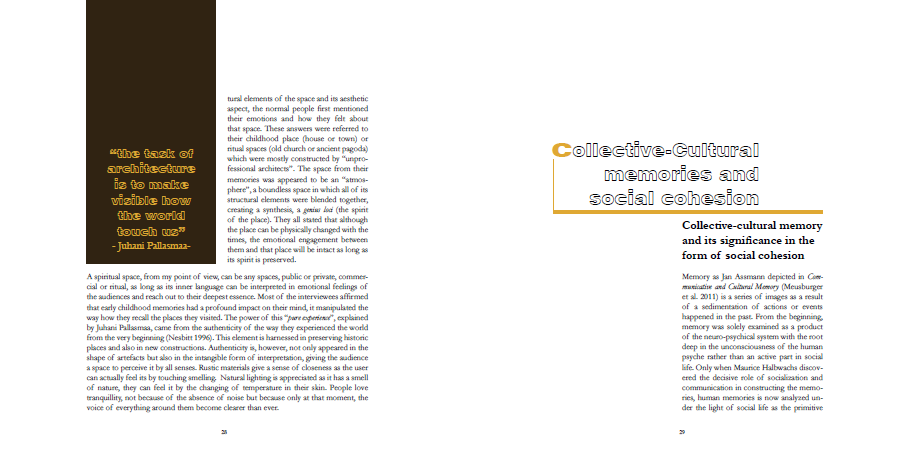[S01.4] Non-religious Spiritual space for social cohesion in Vietnam

3.2 Social cohesion in Vietnamese contemporary society
During the colonial time, the political conflicts and spatial disparity were considered as the main cause of the discontinuity of collective memories in Vietnamese society. In North and South Vietnam, the perception of citizens was systematically manipulated by the political discourse so that the image of each side was deliberately demonized under the eyes of their counterparts. This paraconsciousness, the misconception due to social conflicts (Sabelli 1998) consequently broke down the social cohesion insofar as the social ideologies were changed to the core. As the war ended in 1975, the reconciliation, sadly, had not been processed by a unified government. Very little attempts at promoting a mutual understanding for the reciprocal commitment had been made in this transition period. In contrast, the totalitarian system of the party-state tried to mould the public consciousness into an “official” history by suppressing the existing cultural memories. Atheism went against the ritual beliefs and practices of the Vietnamese whilst cultural identity was oversimplified and re-shaped into the frame of heroic fightings against foreign invaders. Moreover, revolutions in the school curriculum merely placed emphasis on materialism and economic production for public ownership while privacy and individual were heavily criticized as bourgeois thinking, encouraging the polarization in the society. Public ownership, however, did not help to bridge the existing gap in collective memories but became a new obstacle in this sphere. David Middleton and Steven D. Brown cited Halbwachs, that:
“Sociality is not grafted onto subjective experience; it is, rather, the very basis on which one’s sense of individuality is structure. People are always already social beings.” (Meusburger et al. 2011)
In this regard, the mnemonic process of a community was constructed on the basis of individual memories and these personal recollections seem to tie the members to the group that they are belonging to. It is claimed that what differentiates the memory of human beings and other animals is its autonoetic function, in which an individual is able to characterize his identity and at the same time orient himself in the relationship with his contemporaries within the social frame:
“ Only individuals remember, and all experience is individual.” (Meusburger et al. 2011)
Given the marginalization of cultural knowledge and moral values due to the politicalized education system, the social and cultural fabric of memory were degraded. The suppression of individual values only resulted in a fragmented multiplicity of collective recollection. During this period, if the young people were born with a vague consciousness about themselves, the older generation had to live in a dichotomy between dissolving themselves into the public and recalling themselves from the recent past with nostalgia. As the abrupt transformation in society since the Renovation in 1986 so far, despite some positive changes in material and spiritual life in the society, the Vietnamese from both generations are experiencing uncertainty about their identity and their true motivation in their life. The rapid rise of individualism, an “exotic” notion, is more like an imitation among the majority of the young people in order to integrate into Western modernization rather than an in-depth mental revolution. The image of the youth is, thereby portrayed by the pre-war generation as cynical rebellions while the nostalgia and deep roots in the past have stopped the older generation from stepping out of their comfort zone and adopt new values in the new era (figure 02).

memory in Vietnamese society
In the complex context of Vietnamese contemporary society, utilizing memories as an essential catalyst for social cohesion, therefore, should be built up bottom-up, from the inner level to social level before reaching the cultural dimension.
Most of the informants from the interview showed hesitation and confusion as expressing their own experiences as well as their inner feelings from daily interactions. That is to say, the current memories of the Vietnamese are not effective in helping them solve this question. This issue could be explained that the government has paid little attention to set a proper social and cultural frame for memory.
Reference:
Bevan, R. (2006) The destruction of memory- Architecture at war., London: Reaktion Books Ltd.
Bich, L. (2014) ‘Cay da 500 tuoi o ngoai thanh Ha Noi’, [online], available: https://www.phongtuc.vn/cay-da-500-tuoi-o-ngoai-thanh-ha-noi/].
Bouquet, M. (2010) ‘Vietnamese party-state and religious pluralism since 1986: Building the fatherland?’, Journal of Social Issues in Southeast Asia, 25(1), 90.
Caan, S. (2011) Rethinking design and interiors: human beings in the built environment, London: Laurence King.
Can, B. (2017) ‘Architecture and the Social Frameworks of Memory: A Postscript to Maurice Halbwachs’ “Collective Memory”‘, Iconarp International Journal of Architecture and Planning, 5(1), 01-09.
Coles, J. and House, N. (2007) The fundamentals of Interior Architecture, United Kingdom: AVA Publishing SA.
Duiker, W. J. (1995) Vietnam : Revolution in transition, 2nd edition ed., America: Westview Press.
Earl, C. (2010) ‘Vietnam’s “Informal Public” Spaces: Belonging and Social Distance in Post-reform Ho Chí Minh City’, Journal of Vietnamese Studies, 5(1), 86-124.
Fathy, H. (1973) Architecture for the Poor: An experiment in rural Egypt, Chicago- London: The University of Chicago.
Frampton, K. (1992) Modern architecture: a critical history / by Kenneth Frampton, 3rd ed. ed., United Kingdom: Thames & Hudson.
Hickey, G. C. (1967) Village in Vietnam, 4th edition ed., New Haven and London: Yale University Press.
Juhani, P. (2005) The Eyes of the skin- Architecture and the sense, Great Britain: John Wiley & Son.
Libeskind, S. ‘Jewish Museum Berlin‘, [online], available: https://libeskind.com/work/jewish-museum-berlin/].
Lien, Q. (2011) ‘Cay da lang‘, [online], available: http://baothaibinh.com.vn/tin-tuc/19/5972/cay-da-lang].
Marr, D. G. (1984) Vietnamese tradition on trait, 1920-1945, London: University of California Press.
McCarter, R. (2016) The space within- Interior Experiences as the origin of architecture, London: Reaktion Books Ltd.
McLeod, M. W. (2001) Culture and customs of Vietnam, Westport, Conn. ; London: Greenwood Press.
Meusburger, P., Heffernan, M. and Wunder, E. (2011) Cultural Memories: The Geographical points of view, Knowledge and Space, Netherlands: Springer Netherlands.
Nesbitt (1996) Theorizing a new agenda for architecture : an anthology of architectural theory 1965-1995 / edited by Kate Nesbitt, Princeton Architectural P.
Nguyen, C. X. (2015) ‘Mot goc cua Ha Noi “thanh lich” nam 2015‘, [online], available: http://chauxuannguyen.org/2015/10/18/mot-goc-cua-ha-noi-thanh-lich-nam-2015/].
Nguyễn, V. n. H. and Kendall, L. (2003) Vietnam : journeys of body, mind, and spirit, America, London: The University of California Press.
Nisbett, R. E. (2003) The geography of thought : how Asians and Westerners think differently … and why, London: Nicholas Brealey.
Nuttgens, P. (1983) The story of architecture, Great Britain: Butler& Tanner Ltd.
Reeh, H. (2016) ‘Encountering empty architecture : Libeskind’s Jewish Museum Berlin‘, Journal of Art Historiography.
Robinson, J. W. (2006) Institution and home: Architecture as a cultural medium, The Netherlands: Techne Press.
Sabelli, H. (1998) ‘The union of opposites: from Taoism to process theory’, Systems Research and Behavioral Science, 15(5), 429-441.
Solheim, W. (1971) ‘New light on a forgotten past’, National Geographic, 139(3), 330.
teamLab (2018) ‘The way of the sea in the memory of Topography-Colours of life’, [online], available: https://www.teamlab.art/w/sea_topography/].
Templer, R. (1999) Shadows and wind: a view of modern Vietnam, New York: The Penguin Group.
Thuy, T. ‘Gia tri van hoa gieng lang‘, [online], available: http://disanlangviet.com/2109-2/].
Tran, N. T. (1996) Tim ve ban sac van hoa Viet Nam, Vietnam: Ho Chi Minh city Press.
Vinnitskaya, I. (2012) ‘Ground Zero Master plan- Studio Daniel Libeskind‘, [online], available: https://www.archdaily.com/272280/ground-zero-master-plan-studio-daniel-libeskind].
Wright, S. (2015) ‘Streets and Laneways of Ho Chi Minh city‘, [online], available: https://www.regularsteven.com/streets-and-laneways-of-ho-chi-minh-city/].
